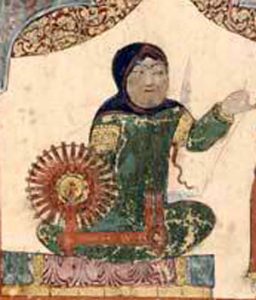
Spinning wheel in China, Song Dynasty (the date is unknown)
Why invent a spinning wheel?
For more than three thousand years everybody used a hand spindle to spin wool, cotton, linen, silk, or hemp into thread. But in the Middle Ages the people of the Islamic Empire were making a lot of money growing cotton and selling cotton cloth, and the people of China were making a lot of money selling silk.
How do hand spindles work?
The history of weaving
Islamic Empire articles
It was hard for the spinning women to keep up – they couldn’t make cloth fast enough. You could hire more women to spin, but then the cloth became too expensive. The invention of knitting about 400 AD may have made this problem worse.
History of knitting
Women in medieval Islam
Who invented the spinning wheel?
Scientists went to work on the problem, using hand cranks that had been invented about 150 AD, and by 1237 AD (or maybe a little earlier) they had invented a machine that could spin four times as fast as a hand spindle – a spinning wheel. Nobody knows whether Chinese or Islamic scientists got there first (and it’s also possible that the first spinning wheels were invented in India, which also sold a lot of cotton cloth). Probably they needed good quality steel to make the wheel spin smoothly and steadily.
Song Dynasty China
More India articles
The history of steel
What else was going on in the 1200s?

Spinning wheel in Baghdad (al-Wasit, 1237 AD)
The Silk Road and spinning wheels
Thanks to the travelling traders of the Silk Road, it didn’t take long to spread the word about the new invention.
What is the Silk Road?
Soon professional spinners all over Europe and Asia were making more clothing more cheaply – with the spinning wheel. Spinning wheels were too expensive for most households – big textile companies owned them, like spinning machines today.
Reaches Africa and Europe
The spinning wheel reached the Delhi Sultanate in India (which also had a major cotton industry) before 1300. It reached North Africa and Islamic Spain by 1350, and northern Europe and Italy before 1400, during the Hundred Years’ War.
More about Islamic Spain
Cotton and medieval India
You’d think the Reconquista, the Black Death, and the Hundred Years’ War would have slowed down scientific progress, but textile manufacturers really wanted this new spinning wheel. Again, that might have been partly because knitting reached Europe about 1250 AD.

Spinning wheel in France, about 1375 AD (Royal 10 E IV f. 146)
Wool on the spinning wheel
In Europe, manufacturers began to use the spinning wheel to spin wool. But these early spinning wheels could only make a light, fluffy yarn that was good for knitting, or for the weft; they couldn’t make the strong string you needed for the warp. So for the warp, women kept on spinning with drop spindles, slowly.
What’s the warp and the weft?
Spinning in West Africa and the Americas
Spinning wheels did not catch on in West Africa or southern Africa, where most cloth production was just for use by your own family, and fine cotton or silk cloth was imported from India or West Asia. Most early European settlers in the Americas also bought their cloth from traders, and soon so did Native Americans.
More about the Navajo
Clothing in the Americas
Even in the American south-west, where Navajo people became shepherds and wove their wool for sale, they kept on moving from place to place, and so they found hand spindles more convenient. Spinning wheels only caught on in places where people needed to produce a lot of cloth quickly for trade.





where is it known from that spinning wheel is 4 times faster?
Well, I suppose ultimately from doing experiments. But here’s a formal citation: Why the Wheel Is Round: Muscles, Technology, and How We Make Things Move, Steven Vogel (2016), p. 217. There’s a footnote which goes to another source, but I haven’t checked that out.